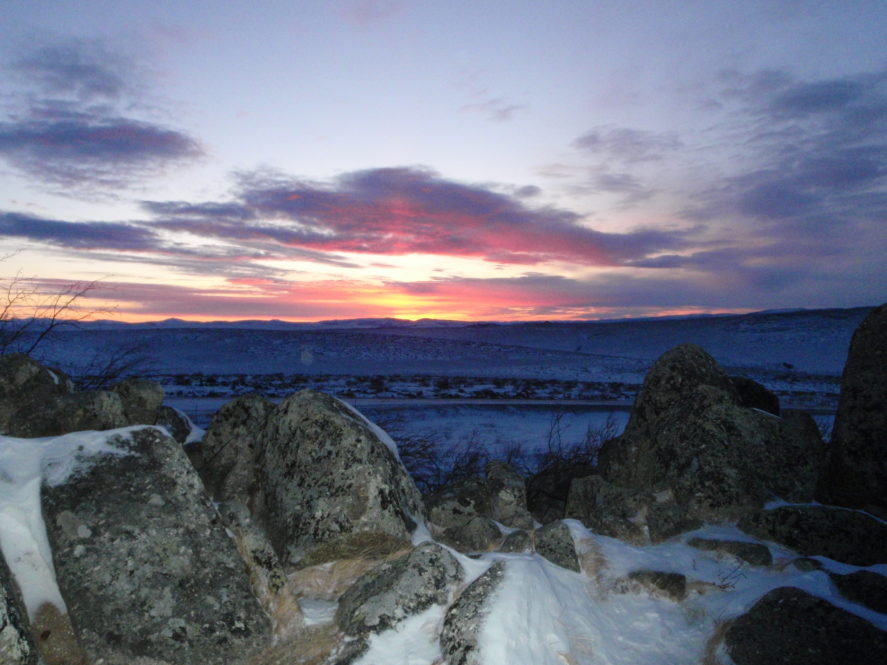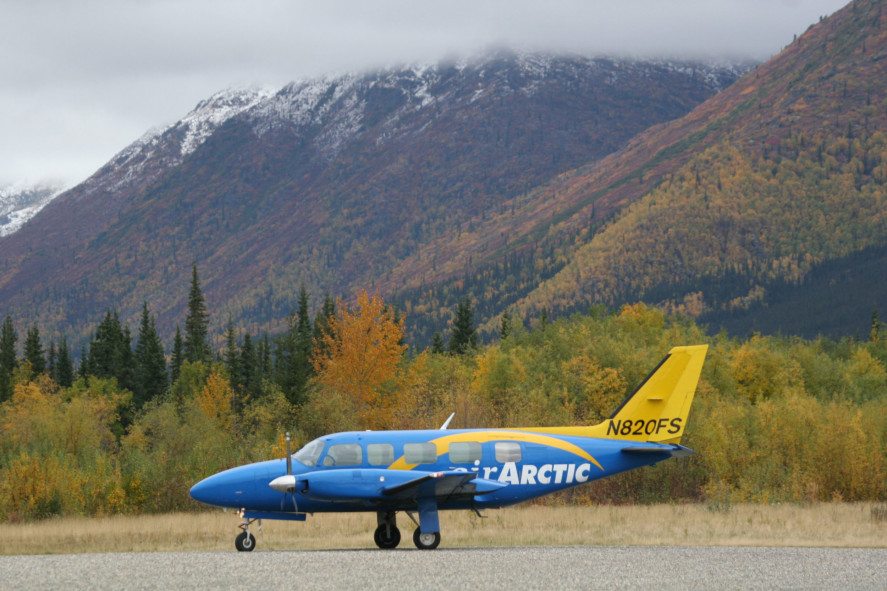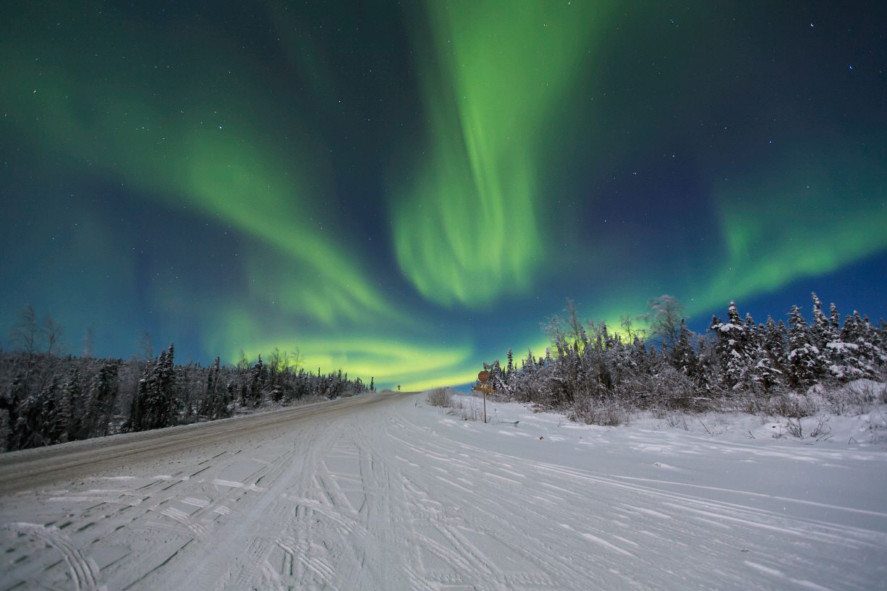In a state defined by extremes and revered for remoteness, there is one region of Alaska where those most fascinating and hardcore Alaskan lifestyles are taken to the max – the Arctic.
This region is full of juxtapositions; a place of cold conditions but warm hearts; an unrelenting Midnight Sun and overwhelming winter darkness; the fierce independent spirit nurtured by subsistence hunting, fishing and survival skills but deep-rooted cultures, traditions and close, caring Alaskan communities. The Arctic is also known for its rich history and the rugged, “nowhere-else-on-Earth” beauty of its lush tundra and end-of-the-world views of coastal plains and jagged mountain peaks.

Winter in the Arctic Circle, Alaska (NATC)
Today, the world is focused on the planet’s Arctic areas as never before, as environmentalists, scientists, political groups, commerce and even military look to better understand, explore and safeguard this remarkable wilderness and its abundant natural resources.
The first and most important thing to know, appreciate and respect about Alaska’s Arctic is its remoteness. Only one major road system connects the Arctic to Fairbanks, Anchorage and Alaska’s other major towns. That’s the Dalton Highway, aka the Haul Road, which is mostly barren and used to haul materials to the oil workers and support industries in the North Slope town of Deadhorse, as well as to work stations along the way.

Scenic still life along Alaska’s Dalton Highway.
Driving the Dalton is a tough but beautiful ride, but travel to and around the rest of Alaska’s Arctic is downright daunting. Getting to Arctic villages and communities most often means flying, and the planes get smaller as your destinations get more remote – for instance, you’ll might take a jet into Kotzebue, but if you’re going further and deeper into the Arctic, you’ll probably board a tiny prop plane packed full of gear.

Arctic Circle Fly Drive Adventure from Fairbanks.
Once transported to your Arctic destination, you’re more likely to travel to nearby sites by snow machine, boat or dog sled than by truck or plane, depending on the season. Accommodations in this area range from backcountry luxury lodges (Alaska style) to make-it-work minimalism (e.g., pitching a reliable tent). And be prepared to get off and stay off the grid. Up North, cell phone coverage is minimal, internet connectivity is a luxury, and groceries, when available, are unbelievably expensive.
The remoteness of the Arctics environs, along with its intense and unpredictable weather and subsistence lifestyles, make most local residents tough, resilient, industrious and highly self-sufficient. Yet all Alaskans living under the harsh conditions of the Arctic recognize the importance of reliance on (and the reliability of) their neighbors, even if they live many miles away. Neighbors are often the first and only line of support in the case of a broken-down boat or a serious medical emergency. These longstanding bonds within communities in the Far North are evident in Alaskan traditions. In Alaska Native villages, the spoils of a successful hunt, fishing or berry harvest are likely shared with community Elders, if not beyond with other families. And filling freezers with game meat (caribou, moose, waterfowl), fish and berries is a year-round, full-time job for family members of all ages.

Traditional Inuit food, reindeer jerky, drying on wooden rack in Barrow, Alaska.
So, why would Alaska visitors want to visit the Arctic? For certain travelers, all of the above. And for many, the Arctic claims a special spot as an “Alaska bucket-list” and “trip-of-a-lifetime” experience.
Some seek a deeper, almost spiritual appreciation for the mysteries of the Arctic, its wilds and lifestyles. The remoteness of this area also creates the most authentic off-the-grid adventures from wilderness and ice camping, to fishing, hunting and packrafting. Riding as a passenger in a floatplane with a birdseye view of the Arctic’s landscapes, then landing on a lake and parking for a few hours of world-class fishing is an unforgettable Arctic day trip.
In each Arctic region, it’s easy to connect with Alaska’s rich history of Alaska Native cultures, the Gold Rush era, the influence of Russian residents past and present, and even dinosaur discoveries – yes, wooly mammoth, dinosaur bones and artifacts from prehistoric travelers to Gold Rush dreamers can be found across the Arctic. And there are also natural gems to explore like the Gates of the Arctic National Park & Preserve, the Brooks Range, and the Arctic National Wildlife Reserve, each attracting a wide variety of adventurers and photographers.

Gates of the Arctic National Park and Preserve caribou.
Others may want to travel as far north as possible on America’s mainland to dip a toe, or take a polar bear plunge, into the Arctic Ocean, then run for warmth. That can happen, with some planning and help from guides, in Utqiaġvik (formerly Barrow) and Deadhorse. Other travelers want to experience the end of the Iditarod Trail Sled Dog Race in the old mining boomtown of Nome or enjoy the first hint of the Arctic’s springtime.

Nome Gold Dredge (Chillylee/Visit Nome)
Travelers often enjoy self-driving itineraries which take them along the Dalton Highway, over the mighty Yukon River and its epic bridge, to cross the Arctic Circle, stop for a ceremonial photo, and spend a night in a rustic cabin in Coldfoot (which lives up to its name if your extremities aren’t properly outfitted). Visits to Arctic travel hubs Kotzebue and Galena also provide an interesting mix of town and village life, with each featuring Alaska Native cultural centers and local routes to smaller villages.

And finally, last but never least, travel anywhere in the Arctic in the winter and if you look to the skies after dark, there are probably some Northern Lights up there. On a clear night, there is nothing more rewarding than these ever-changing colorful lightshows, unique and mysterious, beautiful and magical. For many, that’s reason enough to explore Alaska’s Arctic.

Northern Lights magic as seen from the Dalton Highway.
